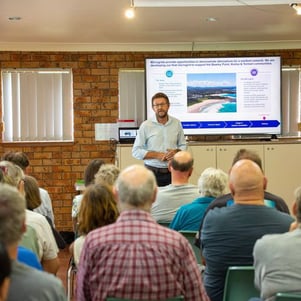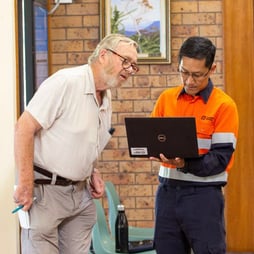Redefining our energy future – first community microgrid in NSW
When the Black Summer bushfires of 2019/2020 hit the south coast of NSW, the picturesque villages of Bawley Point and Kioloa faced devastation. A bushfire that started 80 kilometres away ripped through the region destroying hundreds of homes and left the communities with no power for 11 days.
In response to the vulnerability networks and regional towns face in a changing climate, Endeavour Energy launched the first community microgrid in NSW at Bawley Point and Kioloa late last year.
Energy Insights spoke to Endeavour Energy’s Future Grid Managers, Albert Pors and Dr James Hazelton on why microgrids and smart use of residential solar and battery systems could be the answer to solving power supply challenges in regional Australia.

How did Endeavour Energy decide on the location for the first community microgrid in NSW?
We’d been exploring ways to improve reliability and future electricity services for Bawley Point, Kioloa and Termeil, three popular holiday destinations situated at the far end of our network before the bushfires hit. But the impact of the bushfires highlighted the vulnerability of these regional towns and led us to develop an innovative solution to build an energy-resilient community.
These villages faced several challenges; they are located at the far end of our network with the nearest substation 30 kilometres away, requiring electricity to be delivered through overhead powerlines traversing dense bushland. As a result, the area experiences reliability issues (high SAIDI and SAIFI).
The population also peaks dramatically during holiday periods putting a fourfold increase on local electricity demand. In addition, customers are continuing to install larger 10kW solar systems, causing extreme swings in demand, making voltage management an ever-increasing challenge as more solar energy comes online.
Over time, we had made network enhancements in the region by installing a 1MVA diesel generator to support the grid during peak holiday seasons, as well as targeted LV Statcoms. The conventional long-term network solution would have been to build a new substation closer to Bawley Point and Kioloa, however, we saw an opportunity to ‘build back better’ with a more resilient, more renewable and more reliable electricity grid. That ticked a lot of boxes for the local community.
We were fortunate to receive just under $1 million in funding from the Australian and NSW Governments’ Bushfire Local Economic Recovery Fund which allowed us to offer subsidised battery and rooftop solar systems to residents, guided by strong community engagement. Endeavour Energy funded the remainder of the $8 million project.
How does the community microgrid work?
The project involved the deployment of a large grid-forming battery, a fleet of orchestrated customer owned solar and batteries (under a Virtual Power Plant or VPP) and a Distributed Energy Resource Management System (DERMS) to forecast and coordinate the balancing of local supply and demand.
We call it a community microgrid because we are not just islanding the network from a central point but also working with the assets in customers’ houses to optimise and balance energy use locally.
During periods of high demand or outages, the microgrid will power the community through peak shaving and voltage support from the 2.8MWh network battery and the 138 behind the meter battery and solar systems. The microgrid will help manage peak demand and reverse power flows by charging in the daytime and discharging in the evening peaks, while also providing Volt-Var support to improve power quality.
In the event of an upstream fault, automated network switching will work to quickly to isolate the problem. The large network battery is then enabled which ‘islands’ the microgrid allowing it to re-energise the network and slowly grow the number of customers it can connect.
Behind the meter, residential batteries will support the operation of the grid by smoothing peaks and soaking up excess solar. They can also be called on through the VPP up to 20 times per year, to offer services in local energy balancing. In island events or extreme demand circumstances, we can initiate the VPP to extend the amount of time we power the community. Depending on weather conditions we expect the microgrid to be able to run on local renewable supply for four hours at peak demand periods or longer (potentially continuously) outside of peak demand periods of the year.
We also have several larger customers looking to install solar in the area, so this will allow the microgrid to support the community for longer while islanded.
This microgrid demonstrates several firsts for Endeavour Energy; deployment of a grid-forming network battery; deployment of a virtual power plant controlled by a DERMS; integrated planning of customer energy resources to offset network investment; and effective community engagement to co-design a resilient and reliable local energy network.
How did you get the community on board with such an innovative project?
 A critical part of our engagement with the community was to listen deeply, build trust and demonstrate our commitment to build the microgrid together. Over the last 2 years, we consulted stakeholders widely, and invested time to meet the community in their local community hall to workshop specific issues and hosted numerous online meetings with a local community reference group. Throughout, we were transparent about any hurdles we faced and made sure the community always had a voice - particularly when it came to deciding the subsidies they would pay for the battery and solar systems and the times they can be controlled.
A critical part of our engagement with the community was to listen deeply, build trust and demonstrate our commitment to build the microgrid together. Over the last 2 years, we consulted stakeholders widely, and invested time to meet the community in their local community hall to workshop specific issues and hosted numerous online meetings with a local community reference group. Throughout, we were transparent about any hurdles we faced and made sure the community always had a voice - particularly when it came to deciding the subsidies they would pay for the battery and solar systems and the times they can be controlled.
Combined, this developed very high levels of trust and respect with residents and local community leaders and gave us the social licence we needed to proceed.
What role can microgrids play in the energy transition?
Microgrids are important in providing energy to remote and regional parts of Australia. Microgrids can offer low-cost solar and storage and reduce dependence on fossil fuels. What’s perhaps most novel about this use case is that it has demonstrated the economics of deploying a microgrid to underserved and fringe-of-grid connections, particularly where needs of load growth, reliability and CER management overlap.
Distributed smart resources and digitalisation of control and switching will allow us to do more with less, and take different approaches to the conventional network solutions, while lowering costs to customers. This type of initiative will also allow us to use similar elements of the microgrid - such as the DERMS, interaction with customer CER and customer-co-designed elements to benefit other areas across the entire network.
Is Endeavour Energy looking at other locations for microgrids?
We’ve already been approached by several interested communities wanting to know more. There are many factors to consider, including network need, community preparedness, and capital and people resources. A microgrid is just one of the solutions we are looking at for areas within our network experiencing significant growth in load and CER.
Endeavour Energy acknowledges its key partners and vendors that helped make the community microgrid possible: Shoalhaven City Council (land for the gird connected battery) Hitachi ABB (grid battery), mPrest (DERMS), Evergen (customer VPP aggregator), Sunny Afternoons (solar and battery installer) and Gridsight (analytics and DOE engine).
We especially want to thank and acknowledge the strong and enthusiastic support we received from Bawley Point and Kioloa residents, without whom this project would not have been possible.
Energy Monthly
Get a different perspective on energy with our monthly newsletter.
Up next
.png)

Creating clarity during the energy transition.
Get a different perspective on energy with our monthly newsletter.

All rights reserved Energy Insights Pty Ltd




